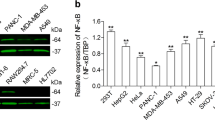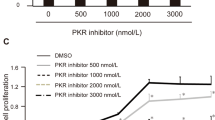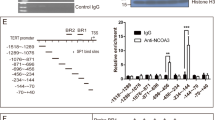Abstract
Overexpression of the transcription factor E2F-1 induces apoptosis in tumor cells. This apoptotic effect is partly mediated through the induction of the double-stranded RNA-activated protein kinase (PKR). Here, we investigate if agents that upregulate PKR could enhance the apoptotic effect of E2F-1 overexpression in liver tumors. In human hepatocellular carcinoma (HCC) cells (Hep3B, HepG2, Huh7), adenovirus-mediated overexpression of E2F-1 (AdCMV-E2F) transcriptionally increased PKR mRNA. The subsequent increase of total and phosphorylated PKR protein was followed by induction of apoptosis. When AdCMV-E2F was combined with the PKR modifier interferon α (IFNα), PKR was additionally upregulated and both PKR activation and apoptosis were increased. Subcutaneous xenograft tumors were selectively targeted using an adenoviral vector expressing E2F-1 under the control of the human telomerase reverse transcriptase (hTERT) promoter (AdhTERT-E2F). Weekly systemic administration of AdhTERT-E2F inhibited tumor growth. The tumor suppressive effect of AdhTERT-E2F therapy was further enhanced in combination with IFNα.Our results demonstrate that PKR activating agents enhance the anti-tumor effect of E2F-1 overexpression in HCC in-vitro and in-vivo. Hence, modulation of PKR is a potential strategy to increase the efficacy of PKR-dependent anti-tumor therapies.
This is a preview of subscription content, access via your institution
Access options
Subscribe to this journal
Receive 12 print issues and online access
$259.00 per year
only $21.58 per issue
Buy this article
- Purchase on Springer Link
- Instant access to full article PDF
Prices may be subject to local taxes which are calculated during checkout




Similar content being viewed by others
Abbreviations
- E2F-1:
-
E2F transcription factor 1
- HCC:
-
hepatocellular carcinoma
- IFNα:
-
interferon α
- PKR:
-
double-stranded RNA-activated protein kinase
References
Shan B, Farmer AA, Lee WH . The molecular basis of E2F-1/DP-1-induced S-phase entry and apoptosis. Cell Growth Differ 1996; 7: 689–697.
Adams PD, Kaelin Jr WG . The cellular effects of E2F overexpression. Curr Top Microbiol Immunol 1996; 208: 79–93.
La Thangue NB . The yin and yang of E2F-1: balancing life and death. Nat Cell Biol 2003; 5: 587–589.
Phillips AC, Vousden KH . E2F-1 induced apoptosis. Apoptosis 2001; 6: 173–182.
Irwin M, Marin MC, Phillips AC, Seelan RS, Smith DI, Liu W et al. Role for the p53 homologue p73 in E2F-1-induced apoptosis. Nature 2000; 407: 645–648.
Muller H, Bracken AP, Vernell R, Moroni MC, Christians F, Grassilli E et al. E2Fs regulate the expression of genes involved in differentiation, development, proliferation, and apoptosis. Genes Dev 2001; 15: 267–285.
Hsieh JK, Fredersdorf S, Kouzarides T, Martin K, Lu X . E2F1-induced apoptosis requires DNA binding but not transactivation and is inhibited by the retinoblastoma protein through direct interaction. Genes Dev 1997; 11: 1840–1852.
Hunt KK, Deng J, Liu TJ, Wilson-Heiner M, Swisher SG, Clayman G et al. Adenovirus-mediated overexpression of the transcription factor E2F-1 induces apoptosis in human breast and ovarian carcinoma cell lines and does not require p53. Cancer Res 1997; 57: 4722–4726.
Vorburger SA, Pataer A, Yoshida K, Barber GN, Xia W, Chiao P et al. Role for the double-stranded RNA activated protein kinase PKR in E2F-1-induced apoptosis. Oncogene 2002; 21: 6278–6288.
Katze MG, DeCorato D, Safer B, Galabru J, Hovanessian AG . Adenovirus VAI RNA complexes with the 68 000 Mr protein kinase to regulate its autophosphorylation and activity. EMBO J 1987; 6: 689–697.
Pain B, Clark ME, Shen M, Nakazawa H, Sakurai M, Samarut J et al. Long-term in vitro culture and characterisation of avian embryonic stem cells with multiple morphogenetic potentialities. Development 1996; 122: 2339–2348.
Kumar A, Haque J, Lacoste J, Hiscott J, Williams BR . Double-stranded RNA-dependent protein kinase activates transcription factor NF-kappa B by phosphorylating I kappa B. Proc Natl Acad Sci USA 1994; 91: 6288–6292.
Hii SI, Hardy L, Crough T, Payne EJ, Grimmett K, Gill D et al. Loss of PKR activity in chronic lymphocytic leukemia. Int J Cancer 2004; 109: 329–335.
Donze O, Abbas-Terki T, Picard D . The Hsp90 chaperone complex is both a facilitator and a repressor of the dsRNA-dependent kinase PKR. EMBO J 2001; 20: 3771–3780.
Adams J, Elliott PJ . New agents in cancer clinical trials. Oncogene 2000; 19: 6687–6692.
George CX, Thomis DC, McCormack SJ, Svahn CM, Samuel CE . Characterization of the heparin-mediated activation of PKR, the interferon-inducible RNA-dependent protein kinase. Virology 1996; 221: 180–188.
Hovanessian AG, Galabru J . The double-stranded RNA-dependent protein kinase is also activated by heparin. Eur J Biochem 1987; 167: 467–473.
Hovanessian AG . The double-stranded RNA-activated protein kinase induced by interferon: dsRNA-PK. J Interferon Res 1989; 9: 641–647.
Meurs E, Chong K, Galabru J, Thomas NS, Kerr IM, Williams BR et al. Molecular cloning and characterization of the human double-stranded RNA-activated protein kinase induced by interferon. Cell 1990; 62: 379–390.
Tanaka H, Samuel CE . Mechanism of interferon action: structure of the mouse PKR gene encoding the interferon-inducible RNA-dependent protein kinase. Proc Natl Acad Sci USA 1994; 91: 7995–7999.
Garcia-Milian R, Rios MA, Amigo M, Diaz D, Guilar O, Silveira M et al. Modulation of human papillomavirus type 16 mRNA in cervical invasive carcinoma patients by interferon-alpha therapy. J Interferon Cytokine Res 1996; 16: 739–743.
Jaster R, Tschirch E, Bittorf T, Brock J . Interferon-alpha inhibits proliferation of Ba/F3 cells by interfering with interleukin-3 action. Cell Signal 1999; 11: 769–775.
Gale Jr M, Katze MG . Molecular mechanisms of interferon resistance mediated by viral-directed inhibition of PKR, the interferon-induced protein kinase. Pharmacol Ther 1998; 78: 29–46.
El-Serag HB . Hepatocellular carcinoma and hepatitis C in the United States. Hepatology 2002; 36 (5 Suppl 1): S74–S83.
Machida H, Nakajima S, Shikano N, Nishio J, Okada S, Asayama M et al. Heat shock protein 90 inhibitor 17-allylamino-17-demethoxygeldanamycin potentiates the radiation response of tumor cells grown as monolayer cultures and spheroids by inducing apoptosis. Cancer Sci 2005; 96: 911–917.
Bostrom PJ, Uotila P, Rajala P, Nurmi M, Huhtaniemi I, Laato M . Interferon-alpha inhibits cyclooxygenase-1 and stimulates cyclooxygenase-2 expression in bladder cancer cells in vitro. Urol Res 2001; 29: 20–24.
Okamoto E, Kinne RK, Sokeland J . Interferons modify in vitro proliferation of human bladder transitional cell carcinoma in the presence of doxorubicin and mitomycin C. J Urol 1996; 156: 1492–1495.
Karti SS, Ovali E, Ozgur O, Yilmaz M, Sonmez M, Ratip S et al. Induction of apoptosis and inhibition of growth of human hepatoma HepG2 cells by heparin. Hepatogastroenterology 2003; 50: 1864–1866.
Soga S, Sharma SV, Shiotsu Y, Shimizu M, Tahara H, Yamaguchi K et al. Stereospecific antitumor activity of radicicol oxime derivatives. Cancer Chemother Pharmacol 2001; 48: 435–445.
Habib NA, Mitry RR, Sarraf CE, Jiao LR, Havlik R, Nicholls J et al. Assessment of growth inhibition and morphological changes in in vitro and in vivo hepatocellular carcinoma models post treatment with dl1520 adenovirus. Cancer Gene Ther 2002; 9: 414–420.
Thongtan T, Panyim S, Smith DR . Apoptosis in dengue virus infected liver cell lines HepG2 and Hep3B. J Med Virol 2004; 72: 436–444.
Pataer A, Bocangel D, Chada S, Roth JA, Hunt KK, Swisher SG . Enhancement of adenoviral MDA-7-mediated cell killing in human lung cancer cells by geldanamycin and its 17-allyl-amino-17-demethoxy analogue. Cancer Gene Ther 2007; 14: 12–18.
Vorburger SA, Pataer A, Swisher SG, Hunt KK . Genetically targeted cancer therapy: tumor destruction by PKR activation. Am J Pharmacogenomics 2004; 4: 189–198.
Acknowledgements
We thank Dr Sunil Chada (Introgen Therapeutics Inc., Houston) for his support and for the AdCMV-Luc vector construct, as well as Dr Bingliang Fang for his help and for the AdCMV-E2F vector construct). This work was supported by Swiss National Science Foundation (SNF 3100A0-104023); Oncosuisse (OCS 01431-08-2003) (SAV).
Author information
Authors and Affiliations
Corresponding author
Rights and permissions
About this article
Cite this article
Roh, V., Laemmle, A., Von Holzen, U. et al. Dual induction of PKR with E2F-1 and IFN-α to enhance gene therapy against hepatocellular carcinoma. Cancer Gene Ther 15, 636–644 (2008). https://doi.org/10.1038/cgt.2008.34
Received:
Revised:
Accepted:
Published:
Issue Date:
DOI: https://doi.org/10.1038/cgt.2008.34
Keywords
This article is cited by
-
The PKR activator, PACT, becomes a PKR inhibitor during HIV-1 replication
Retrovirology (2013)
-
Adenoviral gene therapy in hepatocellular carcinoma: a review
Hepatology International (2013)
-
Implication of protein kinase R Gene quantification in hepatitis C Virus Genotype 4 induced Hepatocarcinogenesis
Diagnostic Pathology (2012)
-
E2F-1 is overexpressed and pro-apoptotic in human hepatocellular carcinoma
Virchows Archiv (2012)



